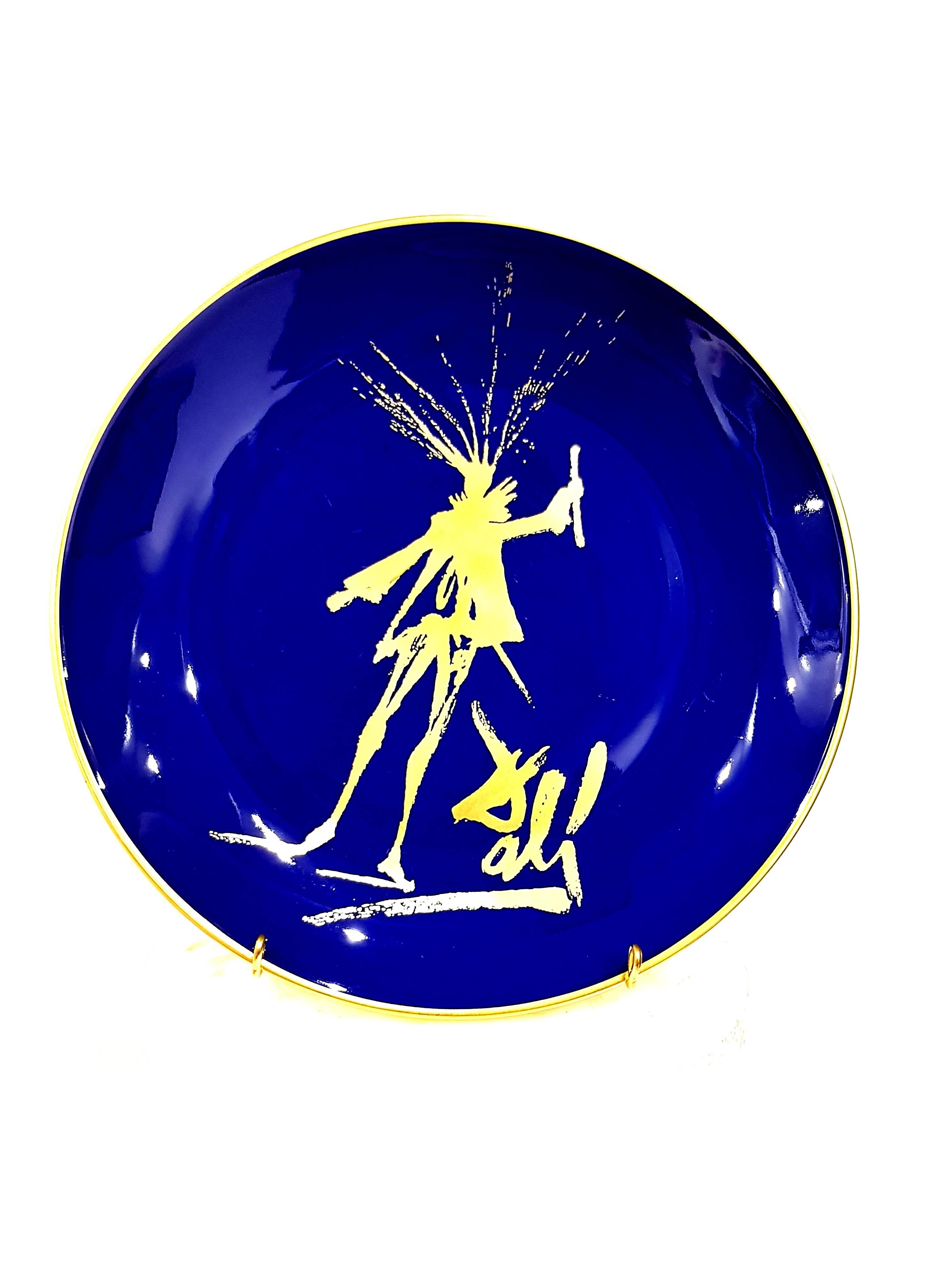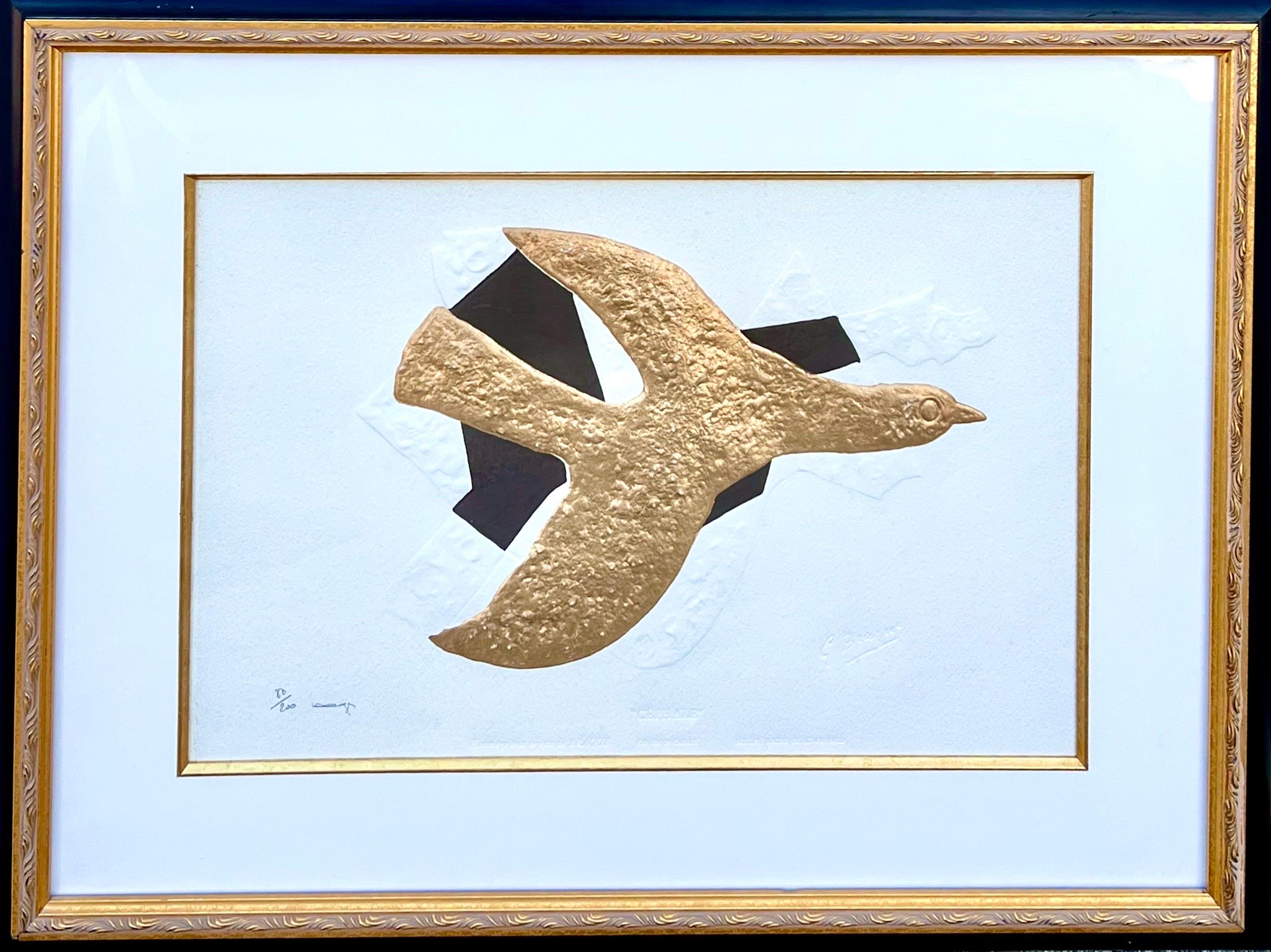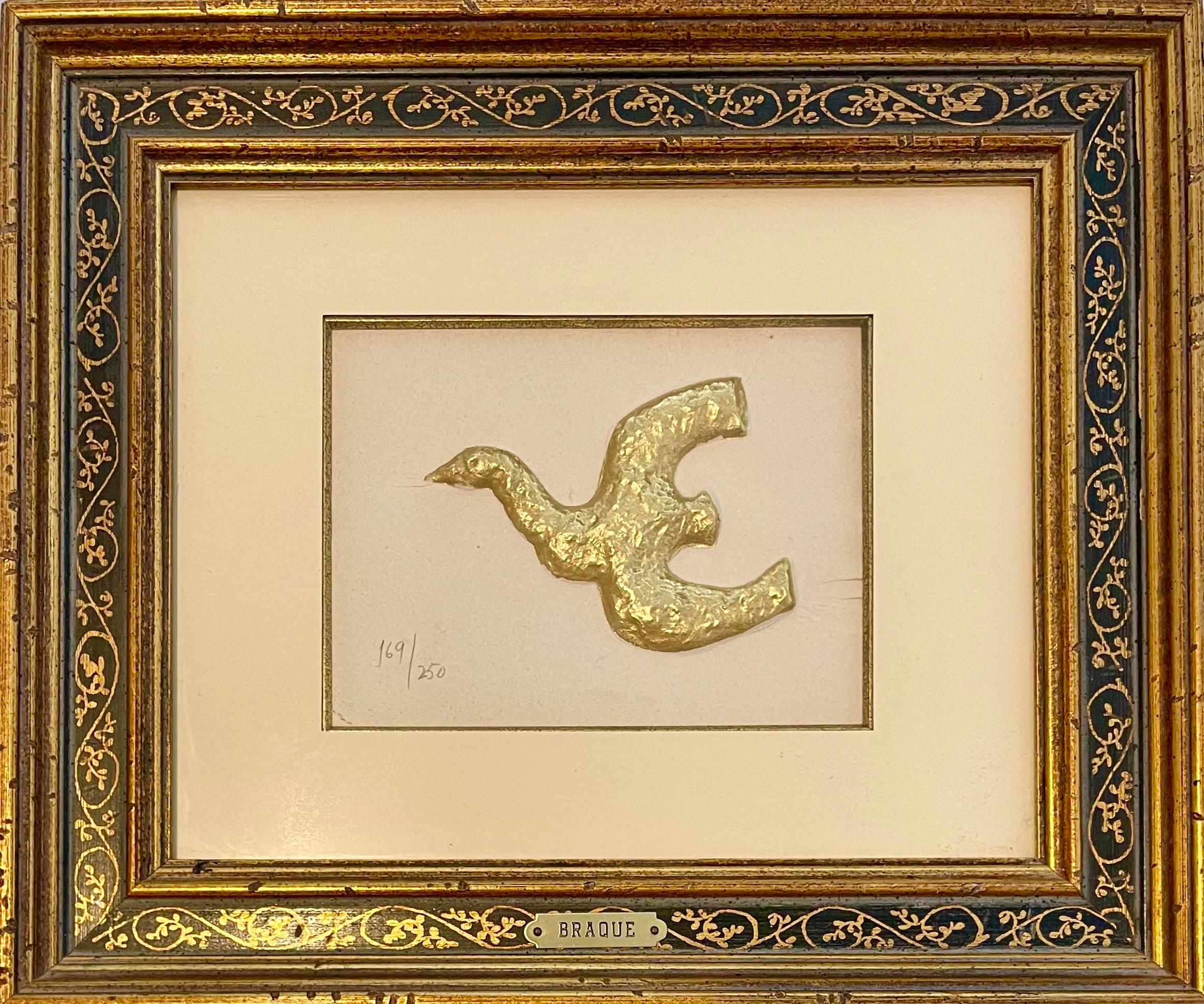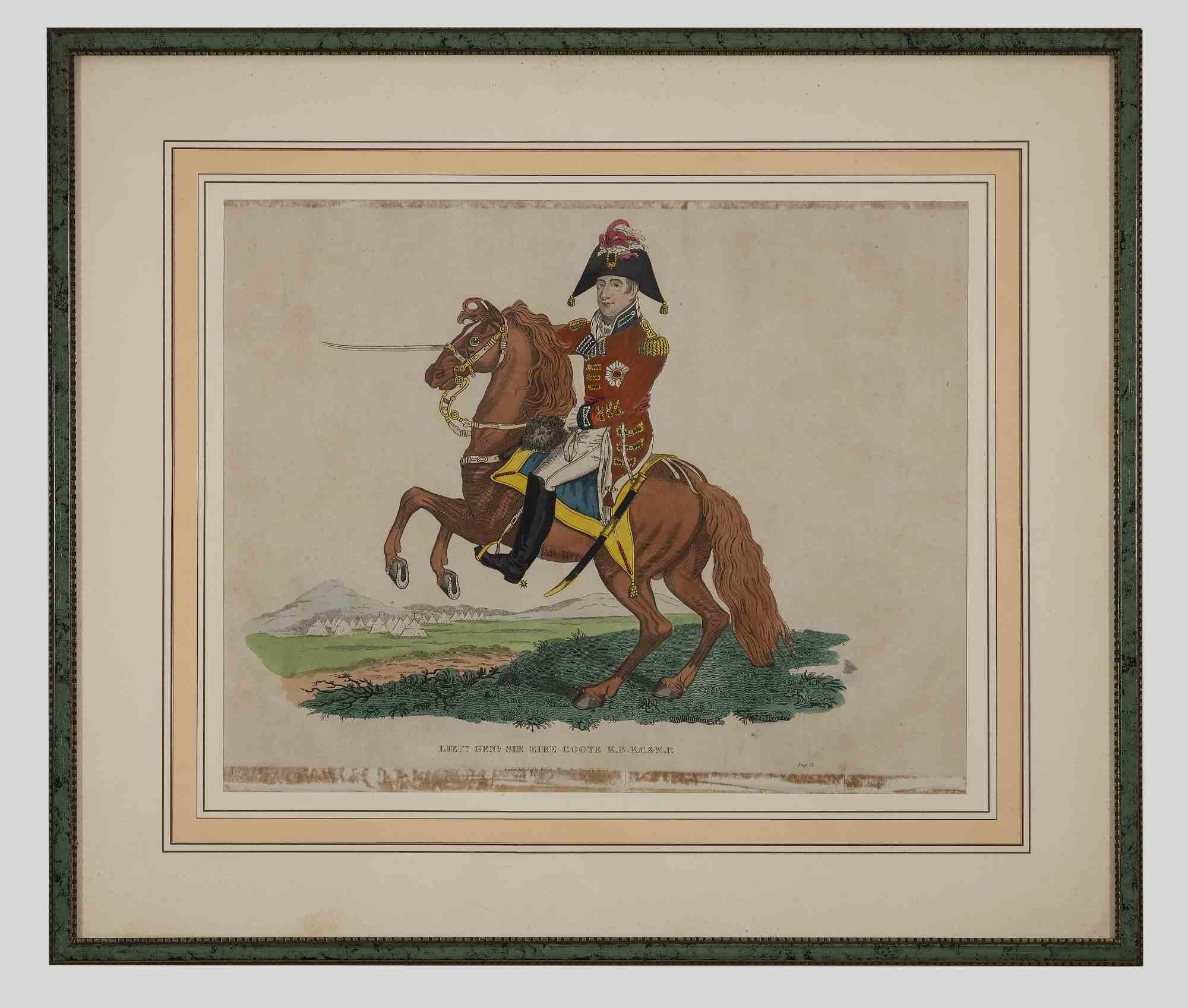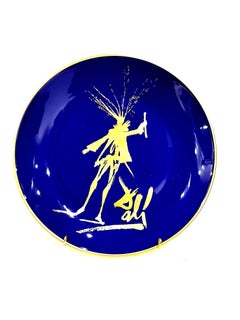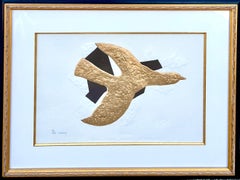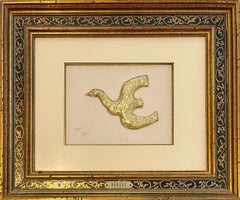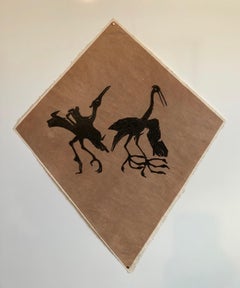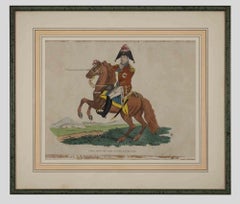Items Similar to Sabat - Limoges Porcelain Blue and Gold
Want more images or videos?
Request additional images or videos from the seller
1 of 9
(after) Salvador DaliSabat - Limoges Porcelain Blue and Gold1968
1968
About the Item
Limoges porcelain in "Bleu de Sèvres" and gold.
Artist: Salvador Dali
Exclusive limited edition to 2000 copies "Raynaud & Co. Limoges", France, 1968.
"Sabat" drawn by Salvador Dalí. Print signed.
Plate Signed in the back of the plate
Dimensions: Diameter: 26 cm
Edited by Salins Earthenware
Sold in its original box
The company "Raynaud-Limoges" specialized in the production of porcelain products in small runs, among the company's customers - crowned people and representatives of the old aristocratic families of Europe.
Dali - the Prodigy Child without an Exam.
Salvador Dali was born as the son of a prestigious notary in the small town of Figueras in Northern Spain. His talent as an artist showed at an early age and Salvador Felipe Jacinto Dali received his first drawing lessons when he was ten years old. His art teachers were a then well known Spanish impressionist painter, Ramon Pichot and later an art professor at the Municipal Drawing School. In 1923 his father bought his son his first printing press.
Dali began to study art at the Royal Academy of Art in Madrid. He was expelled twice and never took the final examinations. His opinion was that he was more qualified than those who should have examined him.
In 1928 Dali went to Paris where he met the Spanish painters Pablo Picasso and Joan Miro. He established himself as the principal figure of a group of surrealist artists grouped around Andre Breton, who was something like the theoretical "schoolmaster" of surrealism. Years later Breton turned away from Dali accusing him of support of fascism, excessive self-presentation and financial greediness.
By 1929 Dali had found his personal style that should make him famous the world of the unconscious that is recalled during our dreams. The surrealist theory is based on the theories of the psychologist Dr. Sigmund Freud. Recurring images of burning giraffes and melting watches became the artist's surrealist trademarks. His great craftsmanship allowed him to execute his paintings in a nearly photo-realistic style. No wonder that the artist was a great admirer of the Italian Renaissance painter Raphael.
Salvador Dali and Gala.
Meeting Gala was the most important event in the artist's life and decisive for his future career. She was a Russian immigrant and ten years older than Dali. When he met her, she was married to Paul Eluard.
Gala decided to stay with Dali. She became his companion, his muse, his sexual partner, his model in numerous art works and his business manager. For him she was everything. Most of all Gala was a stabilizing factor in his life. And she managed his success in the 1930s with exhibitions in Europe and the United States.
Gala was legally divorced from her husband in 1932. In 1934 Dali and Gala were married in a civil ceremony in Paris and in 1958 in church after Gala's former husband had died in 1952. However from around 1965 on, the couple was seen less frequently together. But Gala continued to manage Dali's business affairs.
1933 Salvador Dali had his first one-man show in New York. One year later he visited the U.S. for the first time supported by a loan of US$500 from Pablo Picasso. To evade World War II, Dali chose the U.S.A. as his permanent residence in 1940. He had a series of spectacular exhibitions, among others a great retrospective at the Museum of Modern Art in New York.
Besides creating a number of great paintings, Dali caused the attention of the media by playing the role of a surrealist clown. He made a lot of money and was contemptuously nicknamed Avida Dollars (greedy for dollars) by Andre Breton.
Dali became the darling of the American High Society. Celebrities like Jack Warner or Helena Rubinstein gave him commissions for portraits. His art works became a popular trademark and besides painting he pursued other activities - jewelry and clothing designs for Coco Chanel or film making with Alfred Hitchcock.
The Classic Period After World War II
In 1948 Dali and Gala returned to Europe, spending most of their time either in their residence in Lligat or Spain or in Paris or France or in New York. Dali developed a lively interest in science, religion and history. He integrated things into his art that he had picked up from popular science magazines.
Another source of inspiration were the great classical masters of painting like Raphael, Velasquez or the French painter Ingres. The artist commented his shift in style with the words: "To be a surrealist forever is like spending your life painting nothing but eyes and noses."
In 1958 the artist began his series of large sized history paintings. He painted one monumental painting every year during the summer months in Lligat. The most famous one, The Discovery of America by Christopher Columbus, can be seen at the Dali Museum in St. Petersburg in Florida. It is breath-taking. The artist's late art works combine more than ever his perfect and meticulous painting technique with his fantastic and limitless imaginations.
Salvador Dali is the only known artist who had two museums dedicated exclusively to his works at lifetime.
Dali Museum in St. Petersburg, Florida
The Dali Museum in St. Petersburg in Florida or U.S.A. was founded in 1971 by the Dali collector A. Reynolds Morse and his wife Eleanor. The collection was first exhibited in a building adjacent to their home in Cleveland/Ohio.
In 1982, the museum was moved to St. Petersburg in Florida. It hosts 95 oil paintings including six of Dali's eighteen large-sized historical paintings.
Dali Museum-Theater in Figueres, Spain.
The Dali Museum-Theater in Figueres, Spain was the former Municipal Theater of Figueres. In 1918, when Salvador Dali was only fourteen years old, it had shown his first public exhibition.
Since 1970 the artist had dedicated his energy to transform the former Municipal Theater into a museum and art gallery. In 1974 the Theatro Museo Dali was officially opened.
1980 Dali was forced to retire due to palsy, a motor disorder, that caused a permanent trembling and weakness of his hands. He was not able to hold a brush any more. The fact that he could not follow his vocation and passion of painting and the news of Gala's death in 1982 left him with deep depressions.
After Gala's death he moved to Pubol, a castle, he had bought and decorated for Gala. In 1984, when he was lying in bed, a fire broke out and he suffered sever burns. Two years later, a pacemaker had to be implanted.
Towards the end of his life, Dali lived in the tower of his own museum where he died on January 23, 1989 from heart failure.
- Creator:(after) Salvador Dali (1904 - 1989, Spanish)
- Creation Year:1968
- Dimensions:Height: 0.79 in (2 cm)Width: 10.24 in (26 cm)Depth: 10.24 in (26 cm)
- Medium:
- Movement & Style:
- Period:
- Condition:
- Gallery Location:Collonge Bellerive, Geneve, CH
- Reference Number:1stDibs: LU16122565491
About the Seller
4.9
Gold Seller
These expertly vetted sellers are highly rated and consistently exceed customer expectations.
Established in 2015
1stDibs seller since 2015
918 sales on 1stDibs
Typical response time: <1 hour
- ShippingRetrieving quote...Ships From: Collonge Bellerive, Geneve, Switzerland
- Return PolicyA return for this item may be initiated within 7 days of delivery.
Authenticity Guarantee
In the unlikely event there’s an issue with an item’s authenticity, contact us within 1 year for a full refund. DetailsMoney-Back Guarantee
If your item is not as described, is damaged in transit, or does not arrive, contact us within 7 days for a full refund. Details24-Hour Cancellation
You have a 24-hour grace period in which to reconsider your purchase, with no questions asked.Vetted Professional Sellers
Our world-class sellers must adhere to strict standards for service and quality, maintaining the integrity of our listings.Price-Match Guarantee
If you find that a seller listed the same item for a lower price elsewhere, we’ll match it.Trusted Global Delivery
Our best-in-class carrier network provides specialized shipping options worldwide, including custom delivery.More From This Seller
View AllVenus - Limoges Porcelain Blue and Gold
By (after) Salvador Dali
Located in Collonge Bellerive, Geneve, CH
Limoges porcelain in "Bleu de Sèvres" and gold.
Artist: Salvador Dali
Exclusive limited edition to 2000 copies "Raynaud & Co. Limoges", France, 1968.
"Silhouette de Faust" drawn by...
Category
1960s Modern Mixed Media
Materials
Porcelain
Faust - Limoges Porcelain Blue and Gold
By (after) Salvador Dali
Located in Collonge Bellerive, Geneve, CH
Limoges porcelain in "Bleu de Sèvres" and gold.
Artist: Salvador Dali
Exclusive limited edition to 2000 copies "Raynaud & Co. Limoges", France, 1968.
"Faust" drawn by Salvador Dalí...
Category
1960s Modern Mixed Media
Materials
Porcelain
Jean Picart Le Doux - Sunshine - Original Salins Earthenware
By Jean Picart Le Doux
Located in Collonge Bellerive, Geneve, CH
Original Salins Earthenware Plate
Artist: Jean Picart Le Doux
Title: Sunshine
Signed in the back of the plate
Dimensions: Diameter: 24 cm
Edited by Salins Earthenware
Jean Picart le Doux, French (1902 - 1982)
Jean Picart Le Doux, born in Paris January 31, 1902 and died in 1982, was a French painter and painter-cartonnier the revival of contemporary tapestry.
He is the son of the painter Charles Picart Le Doux (1881-1959).
Without specialized training, he made his debut in bookbinding and publishing, and then he turned to advertising and graphic arts and publishing his first works in 1935. His first tapestry dating from 1943 after winning the Grand Prix of the theater poster exhibition in the imaging.
He met Jean Lurçat and, with Marc Saint-Saëns, gather around him in 1947 for the Association of painters cardboard tapestry.
In 1950, he projects the idea of the Alliance Graphique Internationale, during the meeting with exhibitors of an exhibition of their work in Basel, two other French designers Jean Jacques Colin and Nathan, and two graphic designers Swiss, Fritz Buhler and Donald Brown...
Category
1960s Modern Mixed Media
Marc Chagall - Moses with Tablets of Stone - Original Lithograph
By Marc Chagall
Located in Collonge Bellerive, Geneve, CH
Marc Chagall, Original Lithograph depicting an instant of the Bible.
Technique: Original lithograph in colours
Year: 1956
Sizes: 35,5 x 26 cm / 14" x 10.2" (sheet)
Published by: Éditions de la Revue Verve, Tériade, Paris
Printed by: Atelier Mourlot, Paris
Documentation / References: Mourlot, F., Chagall Lithograph [II] 1957-1962, A. Sauret, Monte Carlo 1963, nos. 234 and 257
Marc Chagall (born in 1887)
Marc Chagall was born in Belarus in 1887 and developed an early interest in art. After studying painting, in 1907 he left Russia for Paris, where he lived in an artist colony on the city’s outskirts. Fusing his own personal, dreamlike imagery with hints of the fauvism and cubism popular in France at the time, Chagall created his most lasting work—including I and the Village (1911)—some of which would be featured in the Salon des Indépendants exhibitions. After returning to Vitebsk for a visit in 1914, the outbreak of WWI trapped Chagall in Russia. He returned to France in 1923 but was forced to flee the country and Nazi persecution during WWII. Finding asylum in the U.S., Chagall became involved in set and costume design before returning to France in 1948. In his later years, he experimented with new art forms and was commissioned to produce numerous large-scale works. Chagall died in St.-Paul-de-Vence in 1985.
The Village
Marc Chagall was born in a small Hassidic community on the outskirts of Vitebsk, Belarus, on July 7, 1887. His father was a fishmonger, and his mother ran a small sundries shop in the village. As a child, Chagall attended the Jewish elementary school, where he studied Hebrew and the Bible, before later attending the Russian public school. He began to learn the fundamentals of drawing during this time, but perhaps more importantly, he absorbed the world around him, storing away the imagery and themes that would feature largely in most of his later work.
At age 19 Chagall enrolled at a private, all-Jewish art school and began his formal education in painting, studying briefly with portrait artist Yehuda Pen. However, he left the school after several months, moving to St. Petersburg in 1907 to study at the Imperial Society for the Protection of Fine Arts. The following year, he enrolled at the Svanseva School, studying with set designer Léon Bakst, whose work had been featured in Sergei Diaghilev's Ballets Russes. This early experience would prove important to Chagall’s later career as well.
Despite this formal instruction, and the widespread popularity of realism in Russia at the time, Chagall was already establishing his own personal style, which featured a more dreamlike unreality and the people, places and imagery that were close to his heart. Some examples from this period are his Window Vitebsk (1908) and My Fianceé with Black Gloves (1909), which pictured Bella Rosenfeld, to whom he had recently become engaged.
The Beehive
Despite his romance with Bella, in 1911 an allowance from Russian parliament member and art patron Maxim Binaver enabled Chagall to move to Paris, France. After settling briefly in the Montparnasse neighborhood, Chagall moved further afield to an artist colony known as La Ruche (“The Beehive”), where he began to work side by side with abstract painters such as Amedeo Modigliani and Fernand Léger as well as the avant-garde poet Guillaume Apollinaire. At their urging, and under the influence of the wildly popular fauvism and cubism, Chagall lightened his palette and pushed his style ever further from reality. I and the Village (1911) and Homage to Apollinaire (1912) are among his early Parisian works, widely considered to be his most successful and representative period.
Though his work stood stylistically apart from his cubist contemporaries, from 1912 to 1914 Chagall exhibited several paintings at the annual Salon des Indépendants exhibition, where works by the likes of Juan Gris, Marcel Duchamp and Robert Delaunay were causing a stir in the Paris art world. Chagall’s popularity began to spread beyond La Ruche, and in May 1914 he traveled to Berlin to help organize his first solo exhibition, at Der Sturm Gallery. Chagall remained in the city until the highly acclaimed show opened that June. He then returned to Vitebsk, unaware of the fateful events to come.
War, Peace and Revolution
In August 1914 the outbreak of World War I precluded Chagall’s plans to return to Paris. The conflict did little to stem the flow of his creative output, however, instead merely giving him direct access to the childhood scenes so essential to his work, as seen in paintings such as Jew in Green (1914) and Over Vitebsk (1914). His paintings from this period also occasionally featured images of the war’s impact on the region, as with Wounded Soldier (1914) and Marching (1915). But despite the hardships of life during wartime, this would also prove to be a joyful period for Chagall. In July 1915 he married Bella, and she gave birth to a daughter, Ida, the following year. Their appearance in works such as Birthday (1915), Bella and Ida by the Window (1917) and several of his “Lovers” paintings give a glimpse of the island of domestic bliss that was Chagall’s amidst the chaos.
To avoid military service and stay with his new family, Chagall took a position as a clerk in the Ministry of War Economy in St. Petersburg. While there he began work on his autobiography and also immersed himself in the local art scene, befriending novelist Boris Pasternak, among others. He also exhibited his work in the city and soon gained considerable recognition. That notoriety would prove important in the aftermath of the 1917 Russian Revolution when he was appointed as the Commissar of Fine Arts in Vitebsk. In his new post, Chagall undertook various projects in the region, including the 1919 founding of the Academy of the Arts. Despite these endeavors, differences among his colleagues eventually disillusioned Chagall. In 1920 he relinquished his position and moved his family to Moscow, the post-revolution capital of Russia.
In Moscow, Chagall was soon commissioned to create sets and costumes for various productions at the Moscow State Yiddish...
Category
1950s Modern Figurative Prints
Materials
Lithograph
Paul Jouve - Eagle - Original Engraving
By Paul Jouve
Located in Collonge Bellerive, Geneve, CH
Paul Jouve - Eagle - Original Engraving
Editions Rombaldi, Paris, 1950.
Copy on velin creme de Rives
Artwork by Paul Jouve.
Original copper engraving heightened with pochoir.
Paul...
Category
1950s Modern Animal Prints
Materials
Engraving
Jean Dubuffet - original lithograph from XXe Siecle magazine
By Jean Dubuffet
Located in Collonge Bellerive, Geneve, CH
Jean Dubuffet - Original Lithograph from XXe Siecle magazine
1958
Dimensions: 32 x 25 cm
Edition: G. di San Lazzaro.
Unsigned and unumbered as issued
Category
1960s Modern Figurative Prints
Materials
Lithograph
You May Also Like
Rare 18 Karat Gold Leaf Embossed Etching After Georges Braque L'Oiseau d'Or
By Georges Braque
Located in Surfside, FL
Embossed print after Braque, based on his sculpture by the same name.
Embossed in the print paper is "'Cephale', Hommage aux bijoux de braque, or fin 23 carat, sculpt heger de Lowen...
Category
20th Century Modern Figurative Prints
Materials
Gold Leaf
Rare 18 Karat Gold Leaf Embossed Etching After Georges Braque L'Oiseau d'Or
By Georges Braque
Located in Surfside, FL
After Georges Braque (French, 1882-1963)
"L'Oiseau d'Or," embossed cast-paper intaglio with 18K gold paint after Braque's Oiseau brooch design, unsigned...
Category
20th Century Modern Figurative Prints
Materials
Gold Leaf
Mexican Modernist Kite Painting, Stencil, Woodcut Print Hand Signed
By Francisco Toledo
Located in Surfside, FL
Francisco Benjamín López Toledo (born July 17, 1940, Juchitán, Oaxaca) is a Mexican painter, sculptor, and graphic artist. He studied at the Escuela de Bellas Artes de Oaxaca and the Centro Superior de Artes Aplicadas del Instituto Nacional de Bellas Artes, Mexico, where he studied graphic arts with Guillermo Silva Santamaria...
Category
21st Century and Contemporary Modern Mixed Media
Materials
Paint, Woodcut, Stencil
General Sir Eire Coote - Original Water-colored Lithograph - 1816
Located in Roma, IT
General Sir Eire Coote is an original print realized in 1816 ca.
Original mixed colored hand watercolored lithograph .
Title printed on plate on the lower margin.
Published by Ric...
Category
Early 19th Century Modern Figurative Prints
Materials
Watercolor, Lithograph
$540 Sale Price
24% Off
Alexander Emperor - Original Lithograph - 1816 ca.
Located in Roma, IT
Alexander Emperor is an original print realized in 1816 ca.
Original mixed colored hand watercolor lithograph .
Title printed on plate on the lower margin.
Published by Richard Ev...
Category
Early 19th Century Modern Figurative Prints
Materials
Watercolor, Lithograph
Genre Scenes Compositions - Original Artwork after Angelika Kauffmann - 1780
Located in Roma, IT
Genre Scenes Compositions is an original artwork realized in 1780s After Angelika Kauffmann.
The artwork consist in a pair of mixed colored hand wa...
Category
Late 18th Century Modern Figurative Prints
Materials
Paper, Etching, Watercolor

